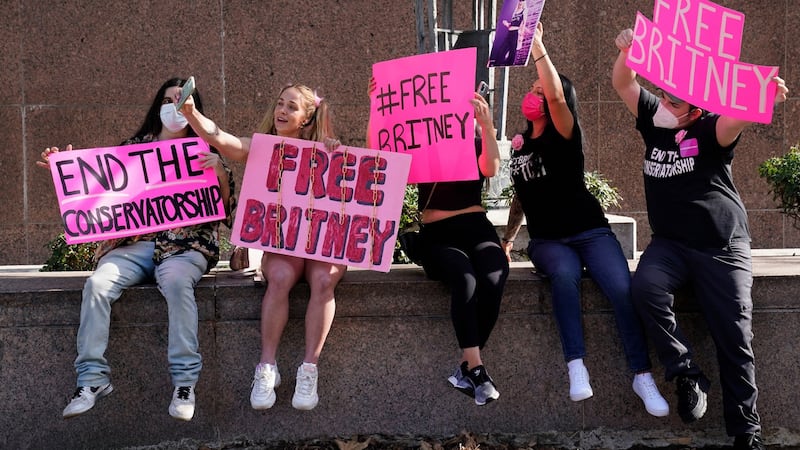A common argument in debates about eligibility for public media funding is that as the lines between different sorts of media outlets have been blurred by technology, artificial distinctions between them shouldn’t be made.
Whenever it crops up, I think about the opposite: how clear those delineations still seem despite all the potential to rub them out.
Yes, news groups with origins in printed newspapers now produce online audio and video, but their brands remain tied up in the power and relative inexpensiveness of the written word.
For even longer, broadcasters such as RTÉ and the BBC have used the internet to explore the delights of text, but this activity has not exactly upended their primary calling cards. As far as any real cross-fertilisation goes, the industry is still at the start of its journey.
Enter Britney Spears, of …Baby One More Time and Oops!... I Did It Again fame. She is in the news again because one newspaper publisher has indeed made a convincing step into the world of television and film production.
Surprise, surprise, it is a company that can afford it: Framing Britney Spears, which charts the media mistreatment and subsequent legal stranglehold placed upon the popstar, is an instalment in the New York Times Presents documentary series.
It is not the first of its documentaries to win acclaim, but it is the first to prompt Irish media sites to post Google-friendly "how do I watch Framing Britney Spears in Ireland?" articles (the answer being you can't, not legally, not yet). The New York Times Company has been trying to crack this for a while now, and with Framing Britney Spears it has a veritable hit on its hands, albeit not one as catchy as Toxic.
Only a cursory knowledge of pop culture is required to be familiar with the grim story of what was done to Britney Spears: a child "Mouseketeer" who appeared on Disney variety show The Mickey Mouse Club, Spears was propelled into stardom in 1998 at the age of 16, but her appealing conveyor belt of songs and videos was suffocated from the start by all the worst aspects of a nudge-nudge music industry exploitation.
Spears was variously styled as a child, a doll, a slave, a girl who was knowing but pure, a singer who thrashed through choruses but was ultimately controllable. And when the pressures of this open creepiness, manipulation and 24-hour scrutiny began to weigh on her mental health, a new generation of media man with a brashly nasty gossip website at his disposal was there in her crowded slipstream to inflate every rational reaction to her hounding into proof of inherent instability. She was labelled “crazy Britney” and poked at repeatedly.

Framing Britney Spears, from producer/director Samantha Stark, explores the miserable outcome for Spears: the use of a US legal instrument called conservatorship to deprive her of the right to control her life and the fortune she earned.
News media companies with ambitions to be more like the New York Times should note that you won’t find this documentary sitting on NYTimes.com next to the latest from Capitol Hill. Instead, it aired on the Disney-owned FX Channel and is now streaming, like the rest of the New York Times Presents series, on FX on Hulu, a hub within the Disney-controlled US service.
On-brand journalism
Its success is therefore the product of both New York Times journalistic heft and mainstream TV industry targeting: Framing Britney Spears manages to be on-brand for the company while helping it reach a new audience. An earlier foray into television production, meanwhile – a star-stacked episodic drama based on New York Times essay series Modern Love – was commissioned by Amazon Prime Video (with characteristic newspaper independence, the New York Times arts desk dubbed it "charming but uneven").
The rewards for judicious media partnering have been evident in the waves caused by Framing Britney Spears, from the celebrities echoing the loyal fan campaign to “Free Britney” to the many apologies.
Gossip blogger Perez Hilton, who recently published a mea-culpa memoir, says he regrets "a lot or most of what I said about Britney". Ex-boyfriend Justin Timberlake, who advanced his solo pop career on the back of an old-school double standard applied to women and sex, has apologised to both Spears and Janet Jackson, the unjust and sole recipient of a puritanical backlash after Timberlake exposed her breast in the choreography of the 2004 Super Bowl half-time show.
What is strange about some of the discussion is the idea that the toxicity of attitudes to Spears – and Jackson – is only evident in retrospect and that it was not obvious as it was playing out. It was and many people said so at the time. Pretending they didn’t is part of the dubious defence that the gleeful media pursuit of Spears at the peak of her difficulties in 2007 was an exercise in giving the public what they want. Every reader and viewer is a little bit to blame, this claim goes.
No excuses
Tell that to the fans who have been trying to right wrongs for 14 years. The press wouldn’t accept this abdication of responsibility from social media platforms. Letting such excuses pass from bullies within their own industry is beyond hypocritical.
Framing Britney Spears reminds us of what can happen when a prowling paparazzi, paid by nefarious business interests, is tacitly supported or barely challenged by the wider media, from the laugh-chasing late night chat shows to the more anodyne magazines that wrapped their rebukes of Spears – often for not much more than the crime of not being 16 anymore – in empty sympathy.
This was ganging-up at its worst. But by giving the “framing” of Spears the spotlight it deserves, the New York Times documentary represents the best of a nascent trend for cross-media aspirations. Sometimes, in trying to break positive ground, it is nice to have friends.











